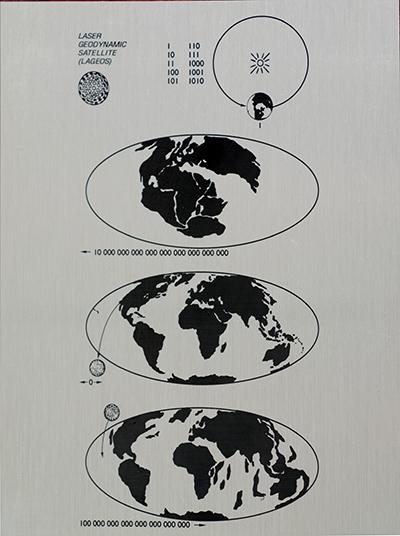Message to the Future
A message has been sealed inside LAGEOS in the event it should be retrieved from orbit or discovered after its return to Earth some 10 million years from now.
The message was prepared by Dr. Carl Sagan of the Laboratory for Planetary Studies at Cornell University, Ithaca, N.Y. Two copies of the message, which is etched on stainless steel sheets measuring 10 by 18 cm (4 by 7 in.), are installed in the satellite – one at each end of the bolt connecting the two hemispheres which make up LAGEOS.

In its upper center, the message displays the simplest counting scheme, binary arithmetic, which uses only zeros and ones. The numbers one through 10 in binary notation are shown. At the upper right is a schematic drawing of the Earth in orbit around the Sun, an arrow indicating the direction of motion. The arrowhead points to the right, the convention adopted for indicating the future. All arrows accompanying numbers are such "arrows of time." Under the Earth's orbit is the binary number one, denoting the period of time used on the plaque -- one revolution of the Earth about the Sun, or one year.
The remainder of the LAGEOS plaque consists of three maps of the Earth's surface, all in a common projection which permits the entire surface of our planet to be viewed at once. Beneath the first map is an arrowhead pointing left, denoting the past, and connected to a large binary number. In decimal notation, this number is equivalent to about 268 million years ago. The map shows the approximate configuration of the continents in the Permian period, about 225 million years ago. The binary number could have been made more accurate, but was "rounded off" to avoid giving the impression of spurious accuracy. Since detailed knowledge of continental drift is still very limited, all the continents are shown together in one mass, sometimes called "Pangaea."
The close fit of South America into West Africa one of the first hints that continental drift actually occurs. Australia is shown as lying originally between Antarctica and West Africa; in other reconstructions, it is thought to have been in contact with Western Antarctica. These maps are not intended to be a precise representation of continental drift, but rather a means of portraying dramatically the existence and extent of continental drift.
The middle map displays the present configuration of the continents. Below it is a symbol indicating zero years, and arrows denoting simultaneously the past and the future; that is, the present. This map represents the zero point in time for the other two maps. LAGEOS is shown being launched into space from the Western Test Range at Vandenberg Air Force Base in California.
The final map is coded by an arrow pointing to the right and a binary number, again rounded off, denoting an epoch 8.4 million years from now – very roughly the estimated lifetime of the LAGEOS spacecraft. The satellite is shown returning to the Earth. Many important changes in the Earth's surface are shown, including the drift of Vandenberg Air Force Base and the rest of Southern California out into the Pacific Ocean. This separation, along the San Andreas Fault, is an expected consequence of the crustal motions which LAGEOS is designed to investigate. Many of the other changes in the map of the Earth shown are little more than guesses. Our knowledge of them should be significantly improved by LAGEOS.
Whoever comes upon the LAGEOS plaque need only compare a current map of the Earth's geography with that in the lower two maps to calculate roughly the time between their own epoch and ours. Drift rates of about an inch per year can, in fact, be estimated by comparing the bottom two maps. Thus, the prime objective of LAGEOS and the method of telling time of the spacecraft's plaque are identical.
LAGEOS will return to Earth at a time in the future more distant than the time in the past of the origin of the human species. The Earth will surely have changed profoundly by that future time and not only with respect to the disposition of its continents. Whoever is inhabiting Earth in that distant epoch may appreciate a little greeting card from the remote past.


